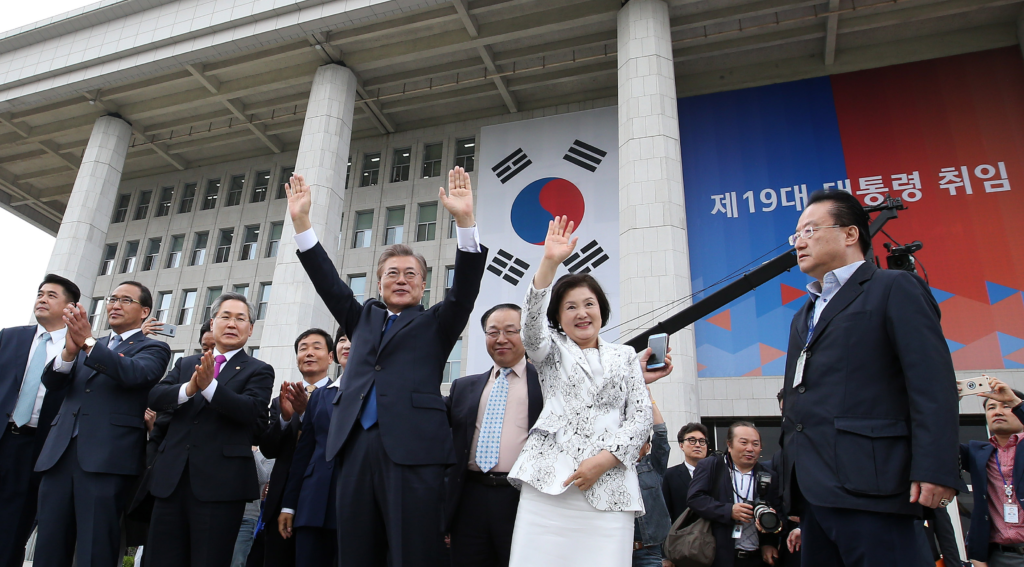A nation must think before it acts.

Inauguration of Moon Jae-in (Source: Korean Culture and Information Service/Flickr)
Through the run-up to South Korea’s presidential election that took place on May 9, 2017, much of the international attention was focused on Moon Jae-in—the clear favorite to win—and his foreign policy ideas and pronouncements. Tensions on the Korean Peninsula have been running high over the past few weeks as the new administration in the White House struck a new tone reacting to North Korean actions and threats that were not necessarily out of the ordinary. Therefore, is not surprising that much of the international attention has focused on Moon’s opinions about issues surrounding North Korea, South Korea’s alliance with the United States. But the recent South Korean election was mainly about domestic issues, and it is far from certain that Moon will enact any paradigmatic changes in South Korea’s policy towards North Korea.
Moon Jae-in was elected in a landslide victory after former President Park Geun-hye was impeached. Her impeachment came after a major corruption scandal sent millions of South Koreans to the streets in protest marches against her. The former president is now “Inmate No. 503” and awaits trial in a detention center in Seoul.
The gravity of the circumstances under which President Park was ousted from power framed the election of her successor. Park stands accused of taking or asking for $52 million in bribes. Her still mysterious collusion with longtime confidant and friend, Choi Soon-sil, symbolized how the South Korean political class is cut off from the reality in which the majority of society lives. Cynicism about the massive socioeconomic gaps, and the excesses of the upper class, is such a deeply ingrained part of South Korea’s political culture that this theme is one of the most common for television dramas. The progressive Moon Jae-in won with a significant margin, receiving over 41 percent of the vote. Conservative candidate Hong Jun-pyo trailed him by 17 points, at 24 percent.
Despite the focus in international media on Mr. Moon’s views on North Korea and foreign policy, it would be wrong to expect any revolutionary, ground-swelling changes in these areas during his presidency. Any significant action to improve relations with North Korea would be politically risky, given the country’s recurring threats against South Korea, and it remains unclear how high the potential rewards really would be. And the alliance between the United States and South Korea rests on a strong fundament of common, strategic interests—likely strong enough to withstand periods of political difference between the leaders of the two countries.
How Far Can Moon Go on North Korea?
Will Moon be more open than his two predecessors to cooperation, exchange, and negotiation with North Korea? The Sunshine Policy was a political banner carried by former South Korean president Kim Dae-jung, who was in office between 1998 and 2003. Basically, it translated into a softer South Korean approach to North Korea, with the South Korean state encouraging private sector investment in the country, and actively seeking cooperation and exchange with the north. In practice, it led to projects such as the Kaesong Industrial Complex, an industrial park in southern North Korea where South Korean firms operated factories where North Koreans worked, with a significant portion of their earnings going to the North Korean state. Then-President Kim Dae-jung travelled to the North Korean capital and met the now deceased North Korean leader Kim Jong-il at a summit in June 2000, a hitherto unprecedented event which gave many hope of a lasting peace and sustainable, closer ties. In 2007, then-President Roh Moo-hyun (in office 2003–2008) also travelled to Pyongyang to meet Kim Jong-il.
During the Sunshine Policy era, the two Koreas also organized meetings between families separated by the Korean War, and exchanges in sports and culture (such as a concert by South Korean pop band Baby Vox in the North Korean capital). Not least, South Korea gave immense amounts of aid to North Korea during the Sunshine Policy. The policy remains a controversial topic in South Korean politics. Many see it as a failure: despite donating millions and millions to North Korea, it continued developing missiles and nuclear weapons that now pose an ever-greater threat to South Korea. It is unclear, to say the least, whether projects such as Kaesong had any noticeable spillover-effects on North Korea’s economic system. Moreover, South Korea largely refrained from criticizing North Korean human rights abuses throughout the Sunshine Policy years, placing warmer relations above all other goals.
Upon coming to power in 2008, conservative President Lee Myung-bak essentially discontinued the Sunshine Policy altogether. The South Korean government closed the Kaesong Industrial Zone in early 2016, as a response to a North Korean rocket test. Kaesong was arguably the most tangible and durable result of the Sunshine Policy years, as it remained in operation through thick and thin, even through occasions such as North Korea’s shelling of South Korean Yonpyong Island in 2010.
Moon has said he aims to bring back the Sunshine Policy, which laid dormant under the two preceding conservative administrations. Within Moon’s political camp, many still favor the Sunshine Policy and see unification with North Korea as a crucial political vision. Moon has explicitly said he wants to re-open Kaesong. Moreover, he was chief-of-staff to President Roh Moo-hyun. Moon has come under criticism for first seeking advice from North Korea about how to act on a UN resolution condemning the North’s human rights abuses, after which South Korea abstained from the vote.
News has also surfaced that Moon’s own pick for chief-of-staff, Im Jeong-seok, was involved in an illegal, pro-North Korean study group for the country’s Juche ideology in the 1980s, under the military dictatorship in South Korea. Im was imprisoned for over three years for helping pro-North Korean activist Lim Soo-kyung travel from South Korea to North Korea, a visit that was highly publicized and used as a propaganda symbol by North Korea. Radical parts of the South Korean left long had close, illegal ties to North Korea, and supported its homegrown Juche ideology of nationalism and self-reliance.
There may well be overtures from Moon to Kim Jong-un (Moon has already stated he would be willing to meet with Kim under the right conditions), but it would be premature to assume that the tense nature of relations between North and South Korea will change under Moon.
First, many issues in South Korean politics are far more important than North Korea to much of the general public. Issues such as economic inequality, poverty, justice and fairness, and the dominant standing of the mega-conglomerates in South Korean society—the chaebols—are only a few examples of domestic issues that many South Koreans see as far more important than the North Korea issue:
- In one poll conducted prior to the election, 17.3 percent of respondents listed economic recovery and revitalization as the most important political issue.
- 3 percent said job creation was most important.
- 12 percent stated “strong security” as their most important issue, but few were specific: only three percent listed issues such as the missile defense system, THAAD, and around two percent picked the North Korean nuclear issue.
The context of President Moon’s election, with the backdrop of a corruption scandal involving the country’s conglomerates, contributed to putting socioeconomic issues front and center. The conglomerates, such as Samsung, LG, and Hyundai, were crucial in taking South Korea out of poverty during the growth and economic transformation of the 1970s and 1980s. But many see their economic dominance as a hindrance to economic growth and vitality, since smaller companies can rarely compete with the economic giants and break into their markets. President Moon may well shake up the Chaebol’s structures, and work to diminish the ties between big business and government that contribute to the sort of corruption that former President Park stands accused of.
Moreover, closer ties and peace overtures toward North Korea—and reunification—are controversial issues in South Korea, and do not always arouse much enthusiasm. The South Korean public—particularly its younger segment—is highly skeptical of reunification with North Korea, not least because of the perception that unification would mean a significant financial burden for South Korean taxpayers. Many in South Korea wonder why they should want to see their tax money spent on investing in a neighboring country whose regime regularly threatens to attack their country with nuclear weapons.
Second, it is unclear what North Korea’s attitude would be to restarting old Sunshine-era projects such as Kaesong, or to opening new avenues. On the one hand, as North Korea’s economy has grown over the past few years, the regime might not see as great of a need as they did in the early 2000s of economic assistance and joint development projects in cooperation with the South. On the other hand, the North Korean middle class is bigger than ever, and hungrier for business opportunities. Perhaps the will to meet the demands of this growing class of citizens will be an incentive for Pyongyang to want to work with Moon’s government on economic projects. Thus far, what little North Korean media outlets have written on the election of President Moon has been relatively neutral in tone, which is itself an interesting break from the blistering, often vulgar, condemnations of the South Korean regime and its officials.
What about the Alliance?
Somehow, over the past couple of decades, South Korea and the U.S. have often gone in opposite political directions. George W. Bush faced two liberal counterparts during his time in office, often causing strain between the two countries on the North Korea issue. There is no shortage of issues that Presidents Moon and Trump could come to square off on:
- Trump has already stirred controversy with his statements about making South Korea pay around $1 billion for the missile defense system, Terminal High Altitude Area Defense (THAAD), which was recently deployed in the country. The deployment of THAAD has strained South Korean ties with China and caused boycotts of South Korean products in China. Moon hopes to mend relations with Beijing. At the same time, asking the United States to remove the system would be a significant blow to U.S.-South Korean relations. Many liberals in South Korea have criticized the deployment of THAAD, seeing it as a tool for the United States to assert its geopolitical power against China, who fears that the system’s deployment is an offensive move against it.
- Particularly during the liberal administrations in South Korea in the late 1990s and early 2000s, coordination of policy vis-à-vis North Korea was often a controversial subject. The Bush administration and the Kim and Roh administrations often disagreed about how to handle North Korean threats, with South Korea under the Sunshine Policy favoring a more conciliatory approach. With Trump in the White House, a similar dynamic may be coming back with the election of Moon.
- Trump has said he might “terminate” or re-negotiate the current free-trade agreement with South Korea. Negotiations over the agreement were thorny, and the trade deal was controversial in both countries, and should Trump open up the issue once more, ties between the two countries may become strained.
But if history is any guide to the future, the alliance as such is unlikely to come under real threat or question. Regardless of political leadership, the U.S. and South Korea have a common strategic interest in deterring North Korea. South Korea continues to benefit from the U.S. presence in the country, and it may be self-evident, but is worth reiterating as worries grow over strains in the U.S.-South Korea relationship. Such strains may well come to grow under Moon and Trump, but issues differences do not necessarily amount to critical risk of a breakup or anything even close.




